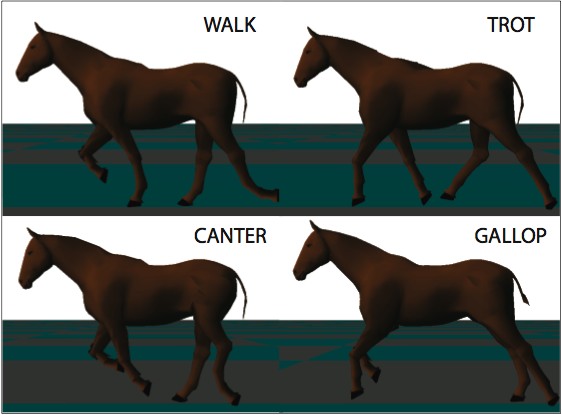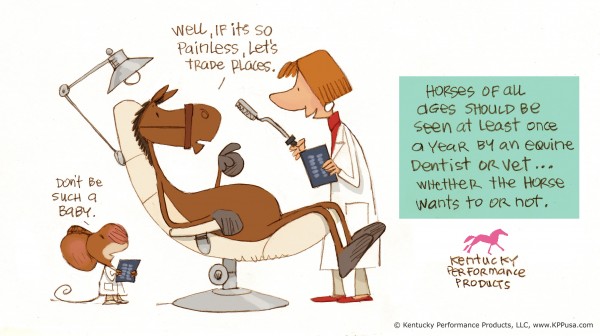
What are Stomach Ulcers?
Ulcers are a common medical condition in horses and foals. It is estimated that almost 50% of foals and 1/3 of adult horses confined in stalls may have mild ulcers. Up to 60% of show horses and 90% of racehorses may develop moderate to severe ulcers. Because they are so common, and can occur as a result of a number of factors, the condition is often called "equine gastric ulcer syndrome" (EGUS) or "equine gastric ulcer disease" (EGUD).
How the horse's stomach works
To understand why horses are prone to ulcers, it is helpful to know some horse anatomy. Holding only about 4 gallons, the horse's stomach is small compared to humans. It is divided into two distinct parts. The non-glandular portion (also called the esophageal region) is lined by tissue similar to the lining of the esophagus. The glandular portion is lined with glandular tissue, which produces hydrochloric acid and pepsin, an enzyme needed for the digestion of food. This part of the digestive system also produces substances to protect the stomach from the effects of the acid and enzymes. In humans, eating stimulates the production of hydrochloric acid. In the horse, however, hydrochloric acid is constantly being produced. So, if a horse does not eat, the acid accumulates in the stomach, and can start to irritate the stomach, especially the non-glandular portion.
Horses were a grazing animal that took in food 24 hours a day. However, we as humans have taken horses off of the open ranges and locked them in stalls and small paddocks. By doing this we have regulated their diets and altered natures way of smoothing the stomach. Horses are typically fed twice a day and it is common for them to go without food for several hours at a time. When the stomach is not taking in feed it has nothing to dilute the acid being produced. This is what initially sets the horse up for gastric ulcers.
What causes gastric ulcers in horses?
There are multiple factors that can increase the risk of ulcers in horses, including:
Fasting (not eating) - Horses evolved to graze, eating many small meals frequently. This way, the stomach is rarely empty and the stomach acid has less of a damaging effect. If horses and foals do not eat frequently, the acid builds up and ulcers are more likely to develop.
Type of feed - The type and amount of roughage play a role in ulcer development. Roughage, because it requires more chewing, stimulates the production of more saliva. The swallowed saliva helps to neutralize stomach acid. There is an increase in acid production when concentrates are fed. The type of roughage is also important. Alfalfa is higher in calcium, and it is thought that this may help decrease the risk of ulcers.
Amount of exercise - As the amount of exercise increases, there is often a change in feeding (e.g., more times of fasting, less roughage), which increases the risk of ulcer development. In addition, exercise may increase the time it takes for the stomach to empty, so large amounts of acid can remain in an empty stomach for a prolonged period of time. Stress itself may decrease the amount of blood flow to the stomach, which makes the lining of the stomach more vulnerable to injury from stomach acid.
Medications - Chronic use of non-steroidal anti-inflammatory drugs (NSAIDS) such as phenylbutazone (Bute) and flunixin meglumine (Banamine® Paste) blocks the production of a particular chemical called PgE2. PgE2 decreases acid production, so when PgE2 levels are low, acid levels are high, contributing to the development of ulcers.
(http://www.drsfostersmith.com/pic/article.cfm)

What are some signs that my horse has ulcers?
- Poor appetite
- Weight loss and poor body condition
- Poor hair coat
- Mild colic
- Mental dullness or attitude changes
- Poor performance
- Lying down more than normal
Does your horse spook, bolt, rear, buck, or kick while riding? Is your horse “girthy”? Is your horse nervous or does it worry? Do you ride a mare, stallion, or sensitive gelding? Do you believe your horse is not happy? Does your horse always seem to be crooked to the right? Does it not want to pick up the right canter lead or do flying changes in that direction? Does your horse have a hard time holding weight? Is it a picky eater? Does it have a dull coat? Has your horse just experienced a recent trauma in their life? Have they been recently moved to a new barn, or their buddy has left? Has your horse's behavior gotten worse as your training proceeds where as it should be getting better? Does your horse colic or stress when the weather changes, either hot, cold, or both?
(http://www.lunatunesfreestyles.com/horse_ulcers.htm)
If you are reading this and saying, "yeah that sounds like my horse" you probably have an ulcer issue. Stomach ulcers are incredibly common and many horses have them. Some are more affect by their ulcers than others. However, I cannot say this enough when horses have issues there is a source. Horses want to please us and when they are refusing there is normally a reason. The reason does not always show itself quickly or easily but with persistence the problem can be solved.
If you have never dealt with ulcers and are unsure contact your veterinarian. Your vet can determine if your horse is a candidate for ulcers according to the symptoms you are noticing. If they feel your horse has ulcers they can confirm it by performing a gastric scope procedure.
If you have never dealt with ulcers and are unsure contact your veterinarian. Your vet can determine if your horse is a candidate for ulcers according to the symptoms you are noticing. If they feel your horse has ulcers they can confirm it by performing a gastric scope procedure.
I really love this excerpt from Cynthia Collins:
"Sometimes people think their horse is having training difficulties, when if fact, the horse is in pain. I have found time and time again, if your horse cannot or will not do something that you think they should be able to do, PUT DOWN THE WHIP, GET OFF, AND START LOOKING FOR A PAIN ISSUE. It may not be easy to find and you need a good vet to help, but I assure you, once you find it, the horse will work willingly. It could be sore hocks, stifles, hooves, backs, ovulation in mares, TMJ, or stomach or hind gut ulcers. There are very few horses that are bad tempered. They usually want to please. Most of the time, the horse is as frustrated as the rider."
What can I do to help my horse?
Step 1
Ulcer healing and prevention of getting new ones is all about controlling the production of stomach acid. This is done through the use of a H2 blocker, they block the action of histamine. Histamine stimulates the production of stomach acid.
There are only a couple medication options.
- Ranitidine which is effective for 8 hours (give 3 times per day)

- Omeprazole which is effective for 24 hours(give once a day).

These medications are expensive however, they are completely worth the money!!
My preference when buying medication is to use horseprerace.com they offer the medications at a greatly reduced rate to ulcer guard. Additionally, they offer free shipping on orders over $250.
It is important to treat the ulcers for at least a 21 day period. Once the ulcers have been treated then you will need to transition your horse to a maintenance product to prevent the ulcers from coming back.
There are many options for maintenance products some of them are: Tums, Maalox, Mylanta, U-Gard, Gastro-Aid, or Neigh-Lox or there are many generic equivalents.
Stomach ulcer recurrence is not an if its when if left untreated. Horses who are prone to ulcer's need to have their diet managed. It is important to make sure these horses have access to hay 24 hours a day. They also need to have low impact easy to digest foods.
Here is a grain free diet plan that is meant to help heal ulcers:
1/4 cup pumpkin seeds (heals everything including stomach)
1/4 cup dried cabbage (L-Glutamine heals the stomach),
1/4 cup Oat Flour/Fiber (heals hind gut; see below),
1 oz. Probiotics (aids digestion, I use Fast Track)
1/2 cup ground Flax seeds or 1 cup of Rice Bran
I mix them with:
1 cup soybean pellets (high protein, low sugar)
2 cup of Alfalfa/Bermuda hay pellets
Alfalfa is recommended for ulcers because it provides greater buffering capacity compared to grass forages for several reasons. First, alfalfa contains higher levels of protein and calcium, both of which buffer gastric acid. Also, alfalfa cell wall contains certain indigestible compounds such as lignin that gives it a greater buffering capacity than grasses.
The best results come from a combination of first treating the ulcers and then working to prevent them from reoccurring. As with anything, you have to change something if you want to see results. Doing the same thing and expecting change will not work.
I want to restate what I said at the beginning...
It is estimated that almost 50% of foals and 1/3 of adult horses confined in stalls may have mild ulcers. Up to 60% of show horses and 90% of racehorses may develop moderate to severe ulcers.
At those numbers, the chances of your horse developing ulcer's is also very high. I have seen huge changes in my horses after they are treated for ulcer's . Better performance, attitude and improved feed utilization.
The first sign that I notice with my horses is normally attitude. I spend a lot of time in the barn and around my horses, I pay attention to the little things. Changes in their attitude tend to catch my attention quickly. When a horse runs up to you in the pasture everyday to go for a ride and then slowly over time you are chasing them... You may need to ask yourself why your horse no longer wants to be caught. There is most likely a reason that they quit wanting to be ridden often times it is some kind of pain. Another sign I notice is how they eat. Horses who show aggression towards their feeder or are reluctant to eat also get my attention. The key to identifying ulcers is noticing the small changes.












